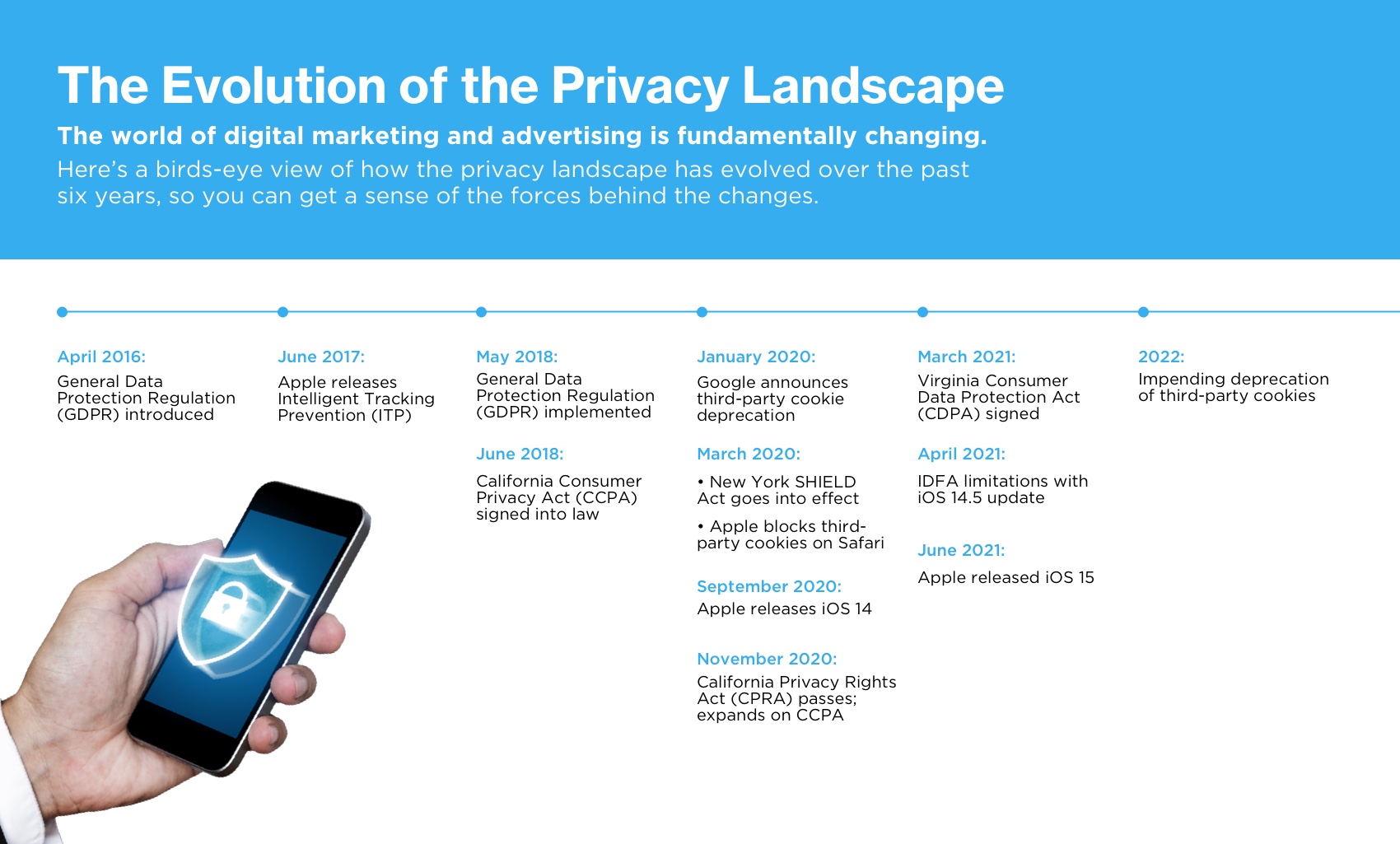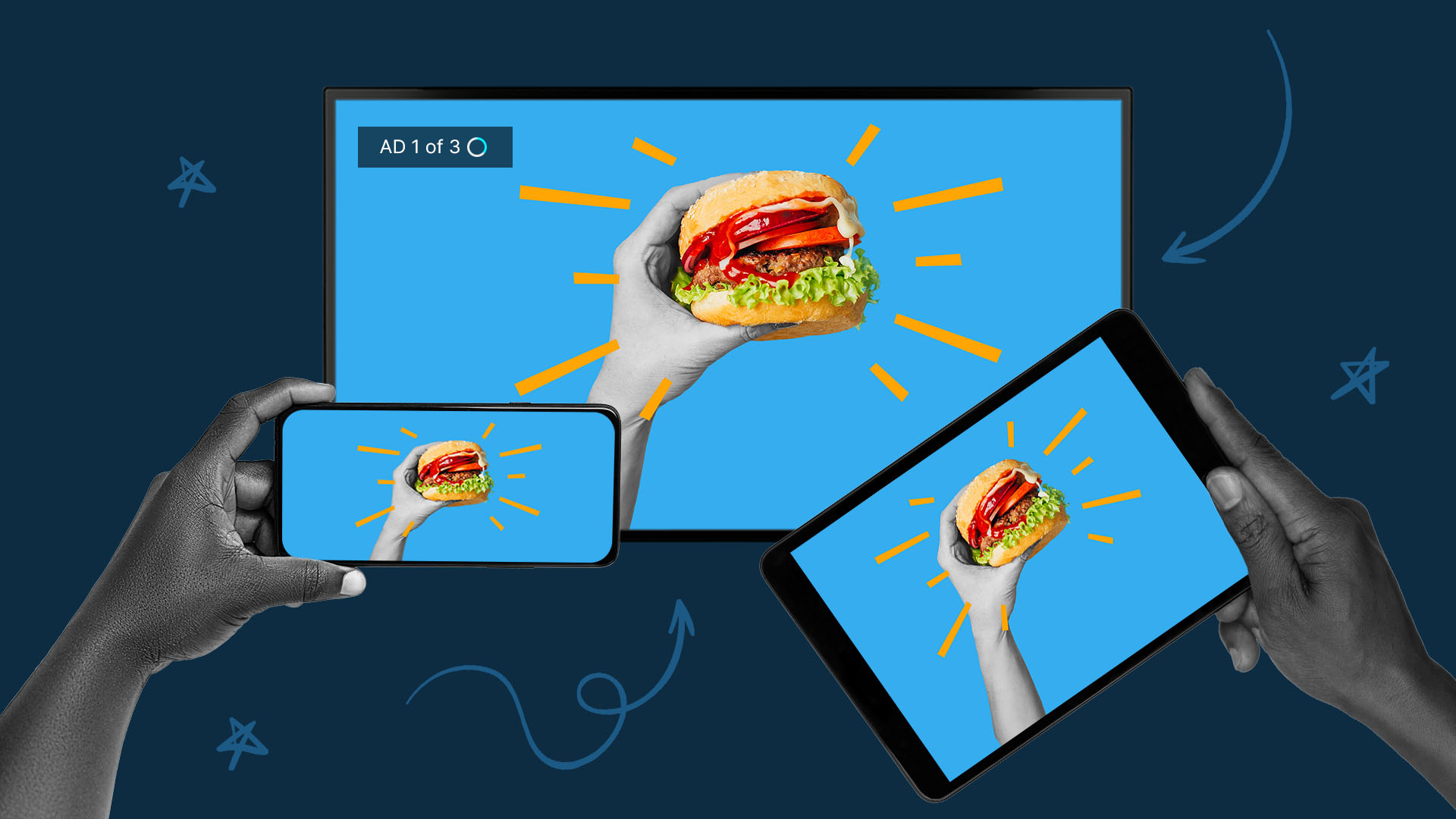The Future of Ad Creative is Data-Driven

Data privacy regulations, especially the ones Apple has recently implemented, are rewriting the rules on how marketers reach their core consumers.
Their App Tracking Transparency (ATT) solution gives iPhone users the choice of opting-in to sharing their data, and with the slew of privacy features that came with the iOS 15 update, like Mail Privacy Protection, individual consumers have more control over how their information is shared with third-parties than ever before.
What does this mean in a nutshell? You’re going to have a lot less individual data about your target audience and how your marketing is performing.
This isn’t a “you” problem; it’s a challenge the entire marketing world is facing.
With increased federal scrutiny over how companies collect and disseminate data, the kind of audience insights marketers have been accustomed to since the birth of the third-party cookie and mobile ad IDs (like Apple’s IDFA) have been deprecated. While that cookie has been crumbling for a few years now, without these important digital tokens, marketers must discover new ways to mine audience insights and optimize digital campaigns.
The best solution may be simpler than you think. With less granular audience targeting data, advertisers must refocus their optimization efforts on the performance of their creative assets, like video advertising. What are the messages that are resonating? What kind of talent does your target audience want to see? Data about nuanced creative elements is more critical than ever before, not just because they can generate insights in a privacy-friendly way, but they can uncover information the human eye may not be able to detect.
In order to do this, brands must engage with data-driven marketing tools to surface nuanced creative insights that will provide a deeper understanding of their customers and how their creative assets perform.
Over 45% of marketers are already operating data-driven strategies that are six times more likely to increase profits annually, so what are you waiting for? Oh right, this guide!
The Data Disruption
You’ve read the press releases, you’ve seen the full page ads, but you may still be asking yourself: what’s actually happening with the future of data privacy? To put it mildly: a lot. Between Google preparing to sunset the third party cookie, and Apple’s recent slate of software updates–including iOS 14.5 and iOS 15–users have more transparency and autonomy than ever before into how their personal data is collected and shared.
These data privacy changes have given consumers considerable control over the information third parties can collect and use for marketing purposes. These are well overdue protections for individual consumer data, but if you’re a marketer who relies on hyper-relevant targeting to efficiently reach your core audience, your job just got a whole lot more complicated.
The audience granularity you’re used to has effectively disappeared. With decreased targeting capabilities, you’ll need to reframe your positioning and creative approach to appeal to a wider audience while still driving action.
Not sure what to do about it? You’re not alone. Here is the high-level timeline so you can chart the journey of the data disruption:

The Way We Measure Impact is Changing
At its core, marketing has always been about trying to understand what a customer likes, wants, and needs and providing that for them through creative messages.
Historically, marketers could rely on gut instincts, focus groups, or market studies conducted by specialized agencies to gain an understanding of how their ad creative resonated with their target audience.
With the proliferation of digital advertising, advertisers could analyze data, like click-through rates and event conversions, to understand the overall effectiveness of their ads. And A/B testing techniques allow marketers to understand the impact of discrete variables, like the use of one closing CTA versus another.
Introducing Data-Driven Creative Analysis
But because of the data-deprecation occurring with Apple’s iOS software updates and the impending demise of the third-party cookie, marketers have begun engaging with new technologies that aim to make their lives easier in this new data ecosystem.
Emerging A.I. and machine learning ad tech tools can provide something even the most advanced creative tests cannot: a deeper understanding of the individual elements that are performing the best in a video ad. These tools surface nuanced insights that you or I may have noticed as we looked at an ad, but had zero clue were so vitally important to a campaign’s performance.
How Does It Work?
Imagine you’re an airline. You’re thrilled travel is booming again, so you want to meet the moment by producing new commercials to entice customers to get back in the air.
You decide to create two ads with different messages; the first about your excellent customer service, and the second about your new low prices. After you run the ads, maybe you notice that the “low price” message is outperforming “customer service”, so you lean into that positioning.
But are the low prices really what’s engaging your audience, or is it something else?
A/B Testing Can Only Take You So Far
This is where standard A/B testing stops. What AI-powered machine learning solutions can do is pinpoint the individual elements of your creative that are generating the strongest results. These could be:
- Video Style (Live Action or animation)
- Tone of Voice
- Setting
- Number of Talent
- Featured Objects
- Featured Words
- And so much more
Seriously, we aren’t being hyperbolic: essentially every aspect of your video creative can be analyzed.
You may analyze all of the videos in your campaign and realize that it isn’t so much the talent or messaging that is having the strongest impact, but the fact that you show what customers will experience in-flight, from highlighting fancy snacks to more legroom than the competition. That will tell you that regardless of your messaging, highlighting the benefits fliers receive riding the friendly skies with your brand is what is most important to your target audience.
Creative Analysis in Action
If you want to see a practical application of this style of creative analysis, we released a study with MNTN breaking down the elements driving the best–and worst–performance on Connected TV. Consider our guide “What Makes the Perfect CTV Commercial” a look-book for the nuanced learnings you can surface through this approach.
Thought starters to consider when wrapping your head around Creative Analytics
- Is my audience interested in learning about individual features, or the lifestyle that comes with our product?
- Do older audience demographics prefer seeing positive or negative messaging?
- What kind of talent will work best on this new social media platform?
- Are customers not going to our digital storefront because our call-to-action is weak, or is it because the ad isn’t dynamic enough?
Related: Creative Analytics: The Next Frontier of Data-Driven Marketing
The benefits of data-driven creative go beyond just the top-line
Increasing ROI is a critical metric–especially to your C-Suite team–but for marketers trying to make headway through the tangled web of privacy changes rewriting the rulebook on data-driven marketing, the greatest benefit of this approach is the simplest: you get better performing ad creative that is produced more efficiently.
When you carry over the nuanced insights surfaced from data-driven creative analysis from campaign to campaign, you’re constantly zeroing-in on what works best in your ads to further refine your creative, increasing your overall performance through each iteration while streamlining in the production process in tandem.
More Confidence Launching on New Platforms
Every platform has its own flavor of content. You probably don’t want to see a 60-second how-to cooking video during a commercial break on Roku or Hulu, but that may be exactly what you are looking for in an ad on Instagram.
Platform integrations with social media channels can allow you to harness data to measure performance and make adjustments in real time. As you gather more performance data about what video elements your audience finds most engaging, you can confidently utilize those learnings to expand your reach onto new platforms.
More Efficient Video Production Process
Every marketer knows that time equals money, and this data-driven approach to analyzing ad creative can save you both and streamline the video production process.
Think of it like this: if you know at the start of your campaign key video elements that are already resonating with your target audience, like talent and location, you won’t need to waste time and balloon your budget by hiring different actors, shooting footage in multiple locations, or holding extensive creative brainstorming sessions to identify what is working with your campaigns.
Nuanced Customer Insights
Before, you may have known whether one video creative was performing better than another, but data-driven solutions allow you to tap into exactly what about your creative resonated with audiences. This, in turn, provides you with a much clearer picture of your target audience.
What about your ad creative speaks to them emotionally? Will a sentimental message carry more weight when compared to a simple Product Spotlight? Essentially, your video creative becomes like a 21st century focus group, revealing learnings on exactly what your customer cares about, both intellectually and emotionally.
Interdepartmental Value
The insights provided by data-driven creative analysis can prove beneficial to other departments within your organization outside of marketing, like Client Services and Product Teams.
Take a meal subscription service, for example. After surfacing learnings from previously produced video ads, they came to a beguiling conclusion. They recognized their ads performed best when featuring chicken or cheese on screen. Sharing this fact with their Product team can provide vital truths about their customer’s preferences. That can be used to make their service even more enticing, like updating their menus to reflect exactly what their consumers are craving.
Do More with Video
Learn how we can help you produce more quality videos affordably and at scale.


